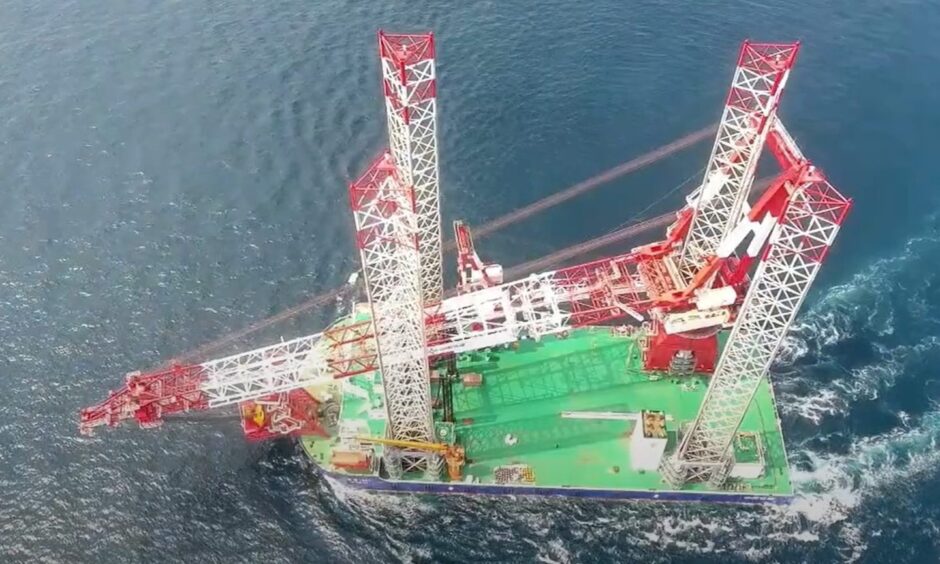
The global offshore wind construction vessel fleet count has been boosted by the recent delivery of two jack-ups (WTIVs) built by Chinese group Shanghai Zhenhua Heavy Industries (ZPMC) for conglomerate China Communications Construction Company (CCCC).
The jack-up double-keel monohulls Haifeng 1001 and 1002 will be operated by CCCC Haifeng Wind Power for deployment in the local and international markets.
The DP2, Ice Class B WTIV sisters measure 134m in length overall by 50m in breadth by 6,6m draft.
Service speed is a little over nine knots. They have a steaming range of 3,000 miles and an operating endurance of 45 days before requiring fresh supplies and fuel.
Their main deck area is configured to carry up to two 15MW wind turbines and their associated components.
A pile-circling, full-slewing crane is fitted on the starboard side at the stern while a lower-capacity auxiliary crane is installed near the bow.
The DP system comprises six thrusters – three x 2,500kW at the nose and three x 3,000kW at the stern.
This is deemed sufficient to handle turbine installation operations in water depths of up to 70m. An 8-point mooring system provides backup in conditions to Sea State 6.
The 130-metre-long lattice legs and associated jacking and other systems are designed to cope with various seabottom soil types including clay and sand.
The sisters differ only with regard to crane lifting capacity. Haifeng 1001’s main crane is rated at 2,500 tonnes, while Haifeng 1002 is 1,800 tonnes.
China has come to dominate the offshore wind construction vessel market and there are currently at least four other units on order/under construction …. All at CIMC Raffles.
They include:
- A 136m vessel for CRCC Harbour & Channel Engineering Bureau (CRCC-HCEB). Designated main crane capacity is 2,000 tonnes – sufficient to handle 15-20MW turbines.
- Two of a potentially four-ship order for Norwegian company Havfram Wind; both GustoMSC NG20000X class units feature hybrid propulsion systems and 3,250 tonne main crane capacity. They will be capable of handling turbines with a rotor diameter of more than 300m as well as XXL monopiles weighing up to 3,000 tonnes in water depths to 70m.
- A super-size 175m vessel for Dutch group Van Oord. It will use methanol as the primary fuel and be capable of handling 20MW turbines. The ship is expected to enter the market in 2024 and will work under the Dutch flag.
Companies Silverstream Technologies and AkzoNobel believe that combining hull bubble lubrication systems with high-end bottom anti-fouling coating could help shipowners reduce fuel bills and improve their carbon footprint.
They’ve published a paper; its title: ‘Exploring Synergy between Energy Saving Solutions for the Maritime Industry’ in a bid to garner a market for their idea.
The International Maritime Organisation (IMO) has set ambitious targets to reduce greenhouse gas emissions from shipping by at least 50% by 2050, compared to 2008 levels.
But the industry is way behind target and goals are unlikely to be met without more radical interventions.
The white paper suggests that the most straightforward pathway to compliance lies in reducing fuel consumption. Hence the two companies teamed up.
London-based Silverstream has made a business out of supplying bespoke pumped air bubble systems to shipowners. Akzo Noble is a Dutch company that develops and manufactures sophisticated hull coating systems.
Akzo Nobel’s Intertrac Vision tool predicts that shipowners could typically save up to 9% on power, 5,000 tonnes of fuel, and over 15,000 tonnes of greenhouse gas emissions over five years when using an ultra-performance fouling control coating.
Silverstream claims fuel and emissions savings of between 5% and 11%, depending on the type of vessel. Even cruise liners like Norwegian Joy are fitted with its pumped bubbles system which itself requires energy to operate.
However, put the two together and further significant benefits apparently become possible.
There is nothing whatsoever new about the phenomenon of air lubrication of hulls.
Anyone who has raced dinghies will know about a phenomenon known as planning. It is when, with sufficient wind, the boat seems to take off, accelerating rapidly, cushioned by masses of generated air bubbles.
The idea of riding on air was possibly known about by the Vikings 1,200 years ago.
Certainly, natural streams of bubbles have been observed travelling along the planking overlaps (lands) below the waterline of modern replica Viking ships, helping to reduce hull friction and raise speed.
Finland’s icebreaker fleet has long made use of hull air bubble systems to help protect the ships from ice damage.
Recommended for you

 © Supplied by China Communications
© Supplied by China Communications © Supplied by Viking Kings A/S
© Supplied by Viking Kings A/S